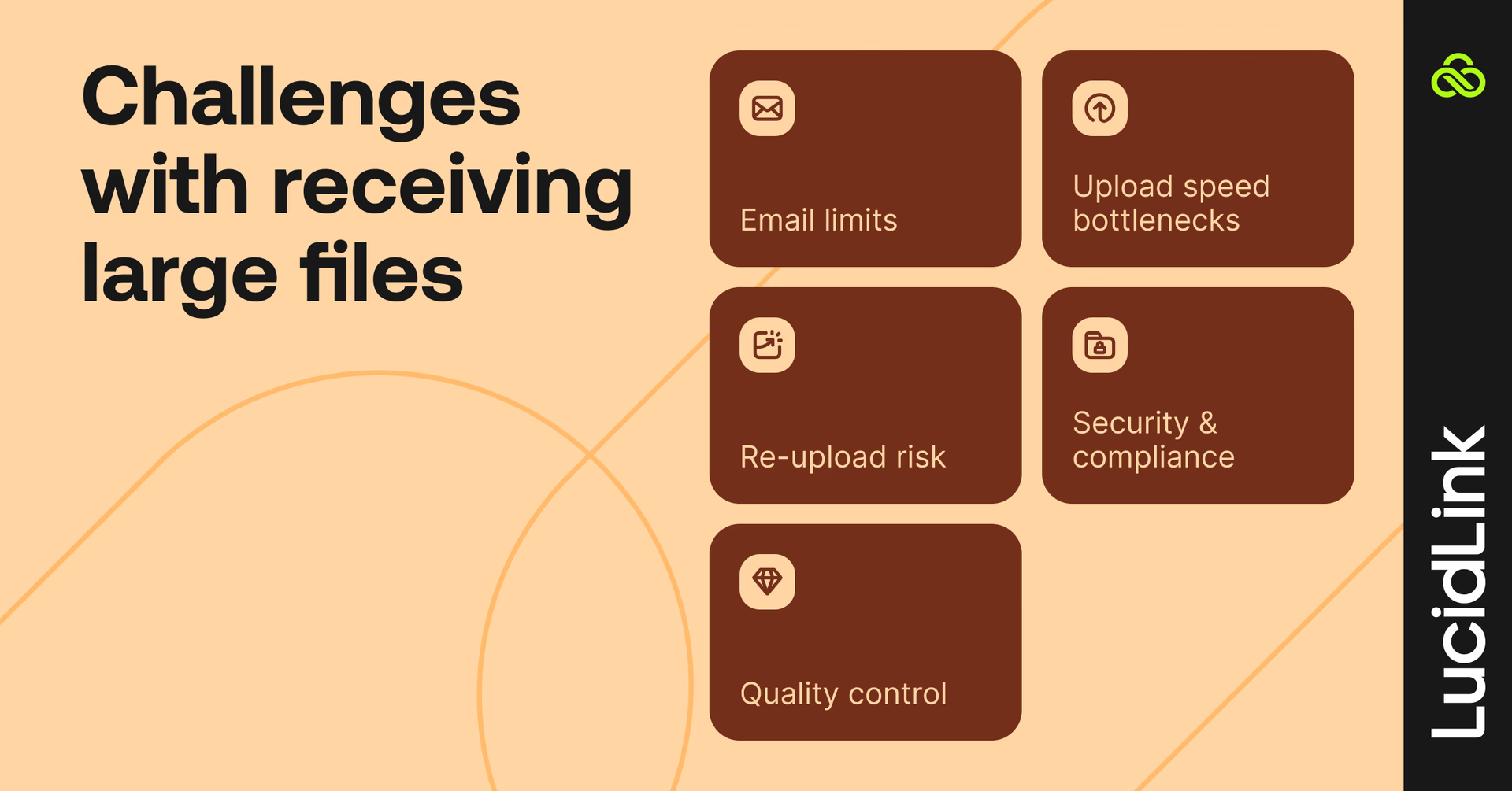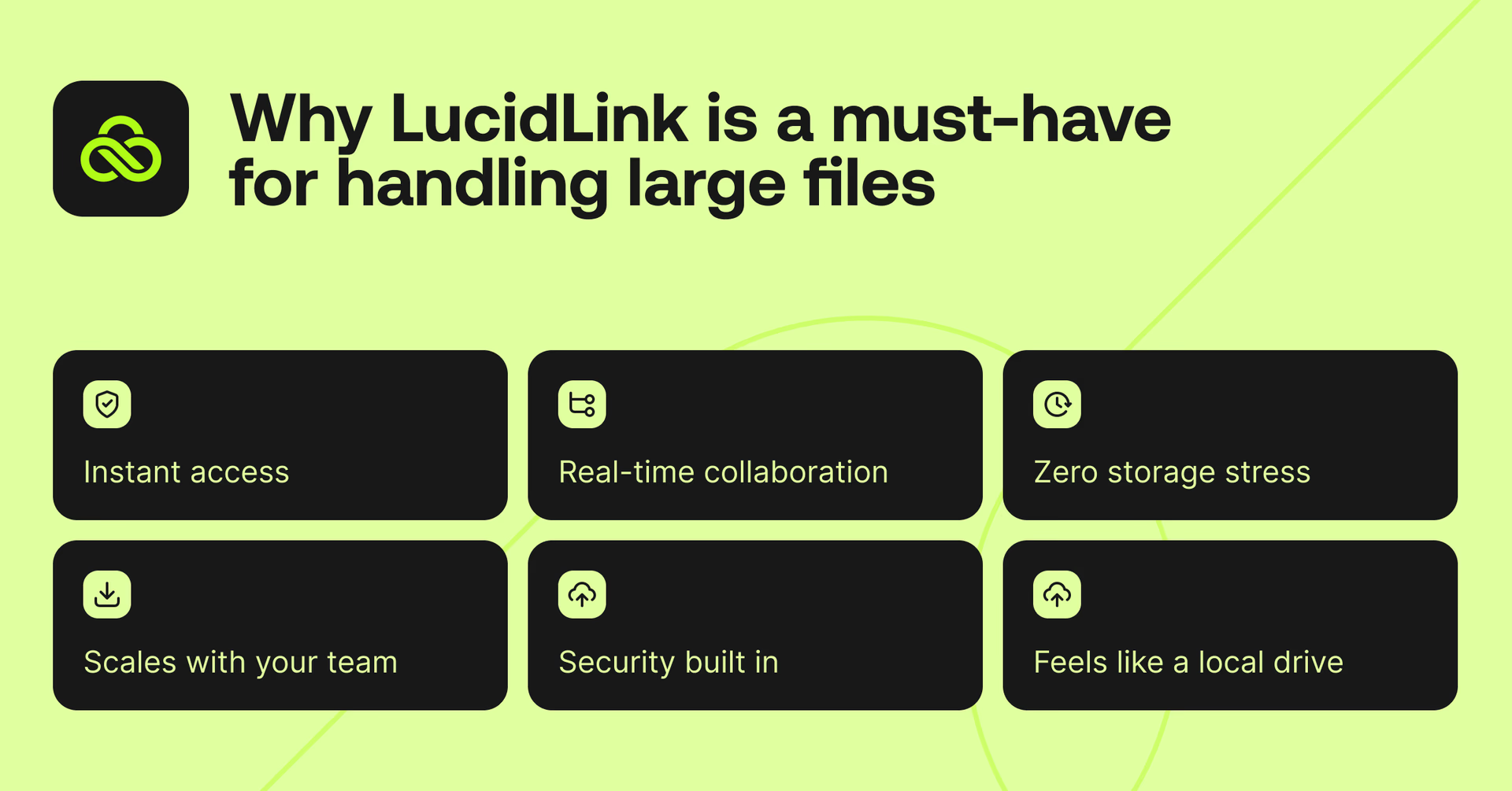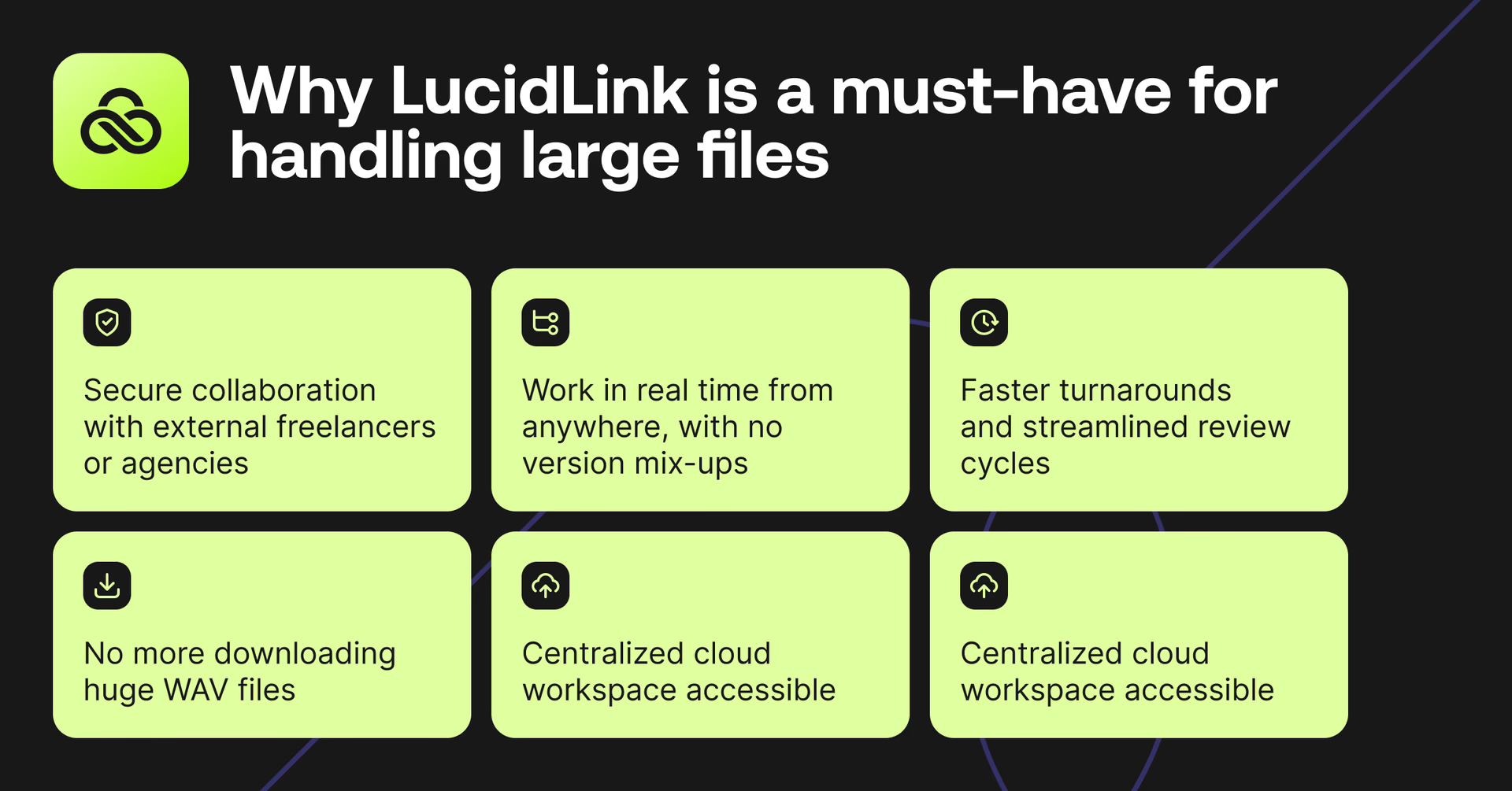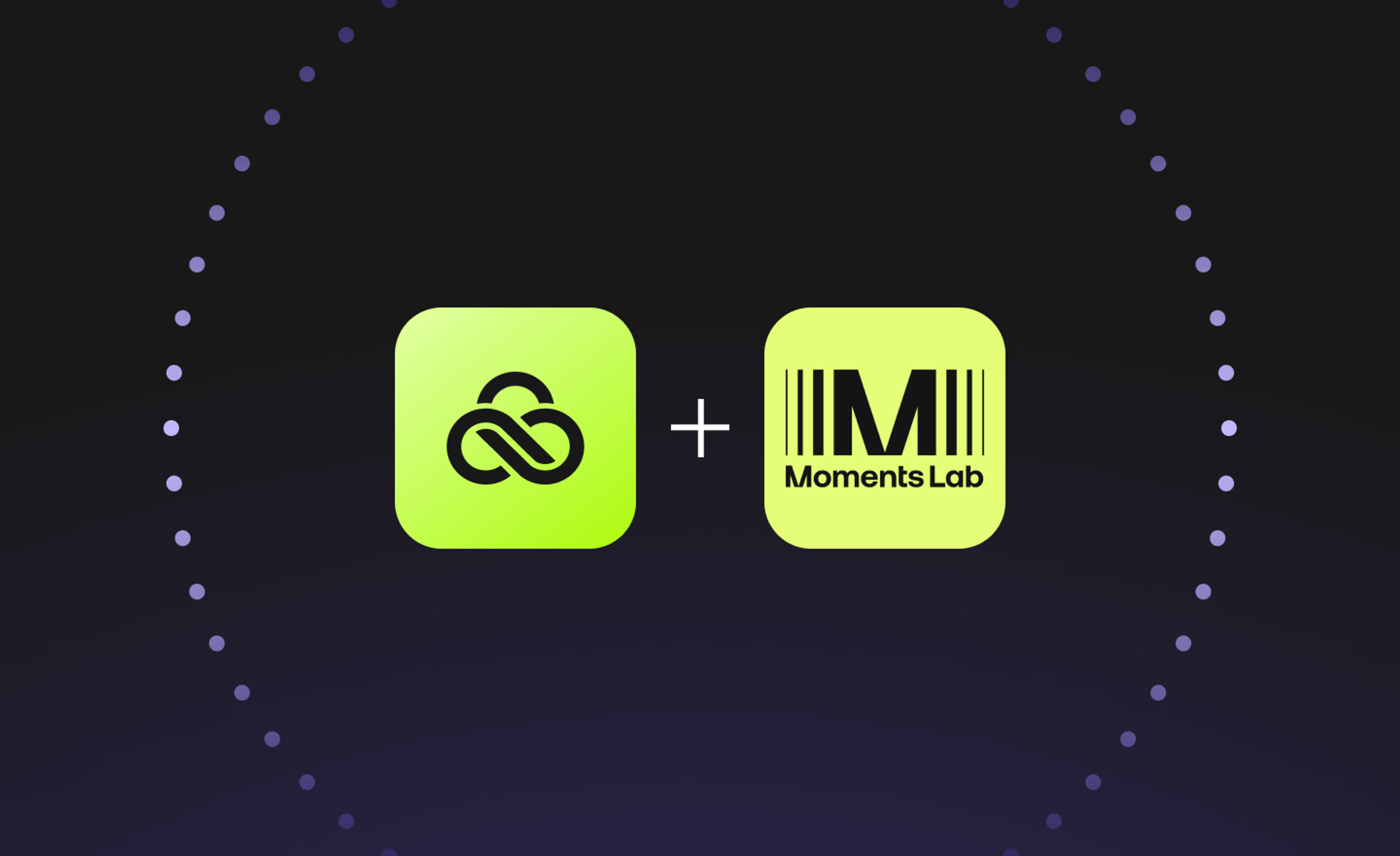Creative production
How to receive large files: 5 fast & secure methods
July 2025
7 mins

Table of contents
Your files, faster.
Access any file instantly, anywhere. Collaborate in real-time from one always-up-to-date, secure cloud filespace.
Your deadline’s looming and the client swears they sent the file hours ago.
But your inbox is empty, the shared folder’s stuck syncing and the progress bar is crawling at a glacial pace.
If you regularly receive large files — whether it’s a raw video shoot, a massive presentation or large design assets, you know this digital limbo all too well.
Missed deadlines, broken links and re-upload requests are just part of the chaos.
But receiving large files doesn’t have to be a stop-start nightmare. In this guide, we’ll break down the best ways to receive large files smoothly and securely — without the waiting, the drama or the dreaded resends.
Why receiving large files is a challenge
Most everyday tools just weren’t built for creative pros handling massive media files. If you’re working with video, high-res images or big design projects, you’ve definitely run into these headaches:

Email limits: Gmail, Outlook and others cap attachments at around 25MB. That’s barely a thumbnail these days.
Upload speed bottlenecks: many senders are stuck on slow home Wi-Fi or outdated connections. Uploading 10GB of footage? Get comfy.
Re-upload risk: one failed upload can mean starting over from scratch. Frustrating and time-sucking.
Security & compliance: when it’s a sensitive project or a high-stakes client, there’s zero room for slip-ups.
Quality control: one glitchy file can bring everything to a halt.
Now add in 4K video, ProRes files or full exports and it’s a recipe for trouble. Not just for your workflow, but for your sanity… and your deadlines.
And let’s be real — sending large files can be just as tricky as receiving them. If you want to make sure your videos arrive in full quality (with no compression drama), here’s our guide on how to send videos without losing quality.
What to look for in tools that receive large files
Not all file transfer solutions are created equal. Whether you’re juggling massive media or tight timelines, here’s what really matters when choosing how to receive large files from clients or collaborators:
No file size limits: because your project files aren’t getting any smaller.
Fast uploads and downloads: time is money, no one wants to watch progress bars.
No login hoops for collaborators: simple, frictionless access means less back and forth.
End-to-end encryption: your files should be locked down and private.
Real-time access or collaboration: access files instantly without waiting for full downloads.
Version control: so you never lose track of edits or updates.
So you know what to look for now. But how do the most popular options stack up?
Whether you’re working solo or with a full creative team, the right tool can save you hours (and stress).
The 5 best ways to receive large files (without losing your mind)
Receiving large files from clients or customers doesn’t have to be complicated. With so many options out there, it’s easy to get overwhelmed or run into technical headaches. Here are five of the best ways to receive large files efficiently and securely.
1. Traditional cloud storage (Google Drive, Dropbox, OneDrive)
Most people use these popular ‘sync and share’ cloud storage services because they’re easy and fast. Do you need to send a document or collaborate on a small project? Just share a link, and you’re done — perfect for quick, simple file swaps.
Pros:
Sharing files is a breeze with simple links
Lots of people already use these services, so your clients probably do too
You can access your files from just about any device — phone, laptop or desktop
Cons:
Syncing and downloading big files is slow, especially if your internet isn’t great
Downloading files takes up space on your computer
When multiple people edit the same file, it’s easy to get confused or overwrite work
Sync and share storage is great for solo gigs or occasional big files. But when deadlines tighten and teamwork ramps up, they quickly hit their limits — slowing down real-time collaboration on large files.
2. LucidLink: skip the send and start working
What if you could receive massive files and start working on them instantly? No downloading, no syncing, no re-linking, no duplicates. Just open the file and go.
That’s the magic of LucidLink.
Here’s what makes LucidLink a must-have for anyone receiving large files from customers, clients or creative collaborators:

Instant access: no syncing or downloading — stream files directly from the cloud and start working
Real-time collaboration: everyone works from the same file, with changes visible instantly.
Zero storage stress: no need to clear space or shuffle external drives
Scales with your team: works whether you’re a solo freelancer, a 100-person production team or a global enterprise with distributed teams
Security built in: end-to-end encrypted with fine-grained access controls
Feels like a local drive: no learning curve — it just shows up as a new drive on your desktop
For a global sports content company like Minute Media, juggling large video files across dispersed teams wasn’t easy. That changed with LucidLink. As Hagai Lazar, VP of Global Video Production, puts it:
“With LucidLink, we upload files to the cloud and work directly from there. There’s no downloading and syncing, making it much easier to manage large files, and we don’t need to ship physical hard drives.”
3. File transfer services (WeTransfer, MASV, Filemail)
File sharing services like WeTransfer, MASV and Filemail make sending or receiving large files quick and easy.
No accounts or complicated setups required — just upload your files, share a link and your client or collaborator can download them instantly. They’re ideal for one-time transfers without the fuss.
Pros:
Quick and easy — no accounts or downloads needed
Often have generous free options or pay-as-you-go plans
Perfect for sending big files once in a while
Cons:
Not built for teamwork — no live editing or syncing
Security isn’t as strong as enterprise tools
Not the best choice for sensitive or regulated info
Files usually expire after a while, which can be tricky for longer projects
Great for occasional big file drops, but not built for ongoing teamwork or sensitive data. For that, you’ll need something stronger.
4. SFTP (Secure File Transfer Protocol)
SFTP is a solid, secure way to receive large files — especially when keeping data safe is a must. It’s popular in industries like healthcare, finance and legal where security and compliance are super important. Unlike regular file transfers, SFTP encrypts your files so no one can sneak a peek.
Pros:
Very secure, great for sensitive or regulated info
No limits on file size
Reliable for regular transfers
Cons:
A bit tricky to set up if you’re not tech-savvy
No features for team collaboration — it’s just for sending files
Less user-friendly than newer cloud tools
SFTP works best when you have IT support or strict security requirements. But if you’re looking for something simpler and more collaborative, there are easier options to use.
5. Portable devices (USB drives, external hard drives)
While it may feel outdated, physically shipping a USB stick or external hard drive can still be a last-resort option — especially when internet access is limited or unavailable.
It’s a reliable way to move large files without relying on connectivity. But for most teams today, there are more efficient and scalable ways to get the job done.
Pros:
Handles massive files easily
Great for backups or when internet is slow or unreliable
Cons:
Can be pricey to ship
Risks of losing or damaging the drive
Not great for remote teams or quick turnarounds
These are best used when internet speed just won’t cut it or as a backup plan.
How LucidLink makes receiving large files easy
When you compare all the options, LucidLink stands out. It’s not just another cloud storage or file transfer service — it’s a new way to access and collaborate on large files.
Forget waiting forever for uploads or downloads. With LucidLink you can access files of any size in real-time, so you can jump straight into editing or reviewing without missing a beat.
No more scrambling for local storage or dealing with endless syncing problems — everything stays in the cloud, saving you space and sanity.
Here’s how LucidLink makes it easy to receive large files:

Stream files in real-time: skip the delays. Start working the moment a file is dropped into your shared space — even if it’s terabytes in size
Skip the downloads: open and interact with massive files instantly, without waiting for them to transfer or sync locally
See updates immediately: as soon as a file is added, it’s available to everyone on the team. No need to notify, resend or re-share
Ready to stop fighting file transfers and start working smarter? Try LucidLink free for 30 days and see how it transforms your workflow.
Keep reading

Creative production
Unlocking the potential of your media library with AI and real-time access
Explore how AI and real-time access make your media library searchable, actionable and ready for faster, smarter storytelling.
16 December 2025, 5 mins read

Creative production
How to build a creative workflow that really flows
Discover how to build a seamless creative workflow using practical strategies and tools. Get tips for collaboration and creative project management.
26 November 2025, 17 mins read

Creative production
Sports video editing: the complete guide for sports highlights and video editing
Learn how to create pro-level sports highlight videos with the best sports video editing software. Tips, tools and real-world workflows included.
20 November 2025, 7 mins read
Join our newsletter
Get all our latest news and creative tips
Want the details? Read our Privacy Policy. Not loving our emails?
Unsubscribe anytime or drop us a note at support@lucidlink.com.